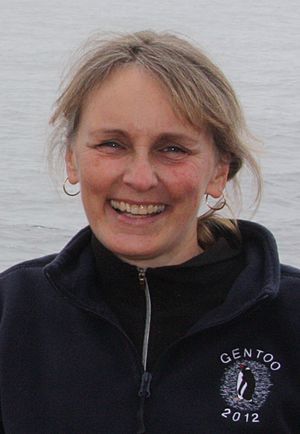Karen Heywood facts for kids
Quick facts for kids
Karen Heywood
|
|
|---|---|
 |
|
| Born |
Karen Joy Heywood
|
| Nationality | Britain |
| Alma mater | University of Bristol (BSc) University of Southampton (PhD) |
| Awards | Georg Wüst Prize (2009) |
| Scientific career | |
| Fields | Physical oceanography |
| Institutions | University of East Anglia Bangor University |
| Thesis | A Lagrangian study of the diurnal heating of the Upper Ocean (1986) |
| Doctoral advisor | Neil Wells |
Karen Joy Heywood is a British scientist who studies the ocean. She is a Professor of Physical Oceanography at the University of East Anglia (UEA). She is well-known for her work using special underwater robots to explore the Southern Ocean, which is the ocean around Antarctica.
Contents
Early Life and Education
Karen Heywood went to the University of Bristol and earned a degree in Physics. She then continued her studies at the University of Southampton. There, she completed her PhD, focusing on how heat moves through different layers of the ocean.
Career and Ocean Research
After finishing her PhD, Karen Heywood worked as a researcher at Bangor University. She studied large swirling currents in the ocean called eddies. These eddies were found near the island of Aldabra in the Indian Ocean.
In 1989, Heywood became a lecturer at the University of East Anglia (UEA). She taught about the physics of the ocean. In 2005, she became a full professor. This made her the first female professor of oceanography in the UK. She has helped train over 40 PhD students. Her goal is to increase the number of scientists who study the ocean by going out to sea.
Exploring the Southern Ocean
During the 1990s, Heywood played a big part in the World Ocean Circulation Experiment. In 1995, she was the lead scientist on a research trip from Antarctica to Brazil. This trip made her very interested in the waters around Antarctica and the Southern Ocean. She has since led many projects in these cold polar regions. She works closely with the British Antarctic Survey team.
Using Underwater Robots
Professor Heywood is a leader in using special underwater robots called underwater gliders. These gliders can travel through the ocean on their own. They collect important information. She currently leads the UEA Seaglider group. She also helps guide other scientists in using these robots to observe the ocean.
She has been on many research trips aboard different ships, including:
- RRS Discovery in the North Atlantic (1984, 1991) and South Atlantic (1993)
- RRS Charles Darwin in the Indian Ocean (1987)
- RRS Challenger in the North Sea (1988)
- RV Wecoma in the Eastern Pacific (1989)
- RRS James Clark Ross in the Southern Ocean, Nordic Seas, Weddell Sea, and Amundsen Sea (1995-2014)
Her work was shown at the Royal Society summer science fair in 2013.
Awards and Recognition
Karen Heywood has received several important awards for her work:
- In 2009, she received the Georg Wüst Prize for her studies in the Southern Ocean.
- In 2016, she was given the Challenger Medal. This award recognized her major contributions to understanding ocean processes, especially in Antarctica. It also honored her work in developing new ways to study the ocean.
- The Society for Underwater Technology (SUT) gave her its Oceanography Award in 2015. They recognized her for being one of the first to use autonomous underwater vehicles (AUVs). These robots carry sensors to collect data. Her work used sea gliders in Antarctica, even under icebergs.
In 2019, Heywood was named a Fellow of the American Geophysical Union. In May 2021, she became a Fellow of the Royal Society. This is a very high honor for scientists in the UK.
Heywood Glacier
In 2020, a glacier in Antarctica was named the Heywood Glacier after her. It is about 18 kilometers (11 miles) long and 3 kilometers (1.9 miles) wide. It flows from the Wegener Range in Palmer Land. The glacier was named to honor Professor Karen Heywood's important work. She has led six ocean research trips to Antarctica since 1995. She is also a pioneer in using autonomous ocean gliders.
In 2022, Heywood was appointed an Officer of the Order of the British Empire (OBE). This award was given for her services to oceanography.
Selected Publications
- Garabato, A.C.N., K.L. Polzin, B.A. King, K.J. Heywood and M. Visbeck, 2004. Widespread intense turbulent mixing in the Southern Ocean. Science, 303 (5655), 210-213. doi:10.1126/science.1090929
- Schmidtko, S., K.J. Heywood, A.F. Thompson and S. Aoki, 2014. Multidecadal warming of Antarctic waters. Science, 346 (6214), 1227-1231. doi:10.1126/science.1256117
- Siddle, E., K.J. Heywood, B.G.M. Webber and P. Bromley, 2021. First measurements of ocean and atmosphere in the Tropical North Atlantic using Caravela, a novel uncrewed surface vessel. Weather, 76 (6), 200-204. doi:10.1002/wea.4004

